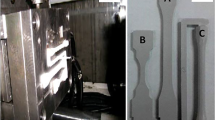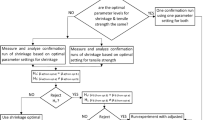Abstract
PC/ABS blends are commonly used for the production of automotive components due to their thermal and mechanical properties. However, changes in process conditions can have a significant impact on their properties and microstructure. Therefore, determining the optimal parameters for the injection molding (IM) process is critical for effective control of the mechanical properties and quality of the injected parts. In this study, the Taguchi method is applied to investigate the relationship between the tensile stress (σ), Young’s modulus (E) and IM process of PC/ABS blends. The effects of different molding parameters such as material temperature, injection pressure, holding time and mold temperature were investigated. The optimal injection parameters to achieve higher tensile stress (σ) and Young’s modulus (E) were predicted by studying the signal-to-noise ratio (S/N). Thus, the objectives of the Taguchi approach for the IM process are to determine the optimal combination of process parameters and to reduce the quality variations between only a few trials. Two optimal parameter combinations were found yielding very significant mechanical properties (σ, E) of the injected parts. These optimum combinations consist of material temperature of 260 °C, injection pressure ranging between 40 and 50 bar, holding time of 8 s and mold temperature of 60 °C. Experimental results prove that injection pressure and material temperature have the most significant impact on the mechanical properties and the microstructure of PC/ABS blends. These findings may have interesting applications in the automotive industry.










Similar content being viewed by others
Abbreviations
- PC/ABS:
-
Polycarbonate/acrylonitrile-butadiene-styrene
- σ :
-
Tensile stress
- S/N :
-
Signal to Noise
- DSC:
-
Differential Scanning Calorimetry
- ATR:
-
Attenuated Total Reflection
- IM:
-
Injection molding
- E :
-
Young’s modulus
- DOE:
-
Design of Experiment
- FTIR:
-
Fourier Transform Infrared
- SEM:
-
Scanning Electron Microscope
References
Zhang J, Hua Y, Liu J, Zhu T, Sun J, Gu X, Zhang S (2023) Constructing flame retardant silica nanoparticles through styrene maleic anhydride copolymer grafting for PC/ABS composites. Compos Part A Appl Sci Manuf 175:107825. https://doi.org/10.1016/j.compositesa.2023.107825
Açık G (2020) Synthesis, properties and enzymatic biodegradation behavior of fluorinated poly(epsilon-caprolactone) s. EXPRESS Polym Lett 3:14. https://doi.org/10.3144/expresspolymlett.2020.23
Fang QZ, Wang TJ, Beom HG, Zhao HP (2009) Rate-dependent large deformation behavior of PC/ABS. Polym 50:296–304. https://doi.org/10.1016/j.polymer.2008.10.042
Pham HT, Weckle CL, Ceraso JM (2000) Rheology enhancement in PC/ABS blends. Adv Mater 12:1881–1885. https://doi.org/10.1002/1521-4095(200012)12:23%3c1881:AID-ADMA1881%3e3.0.CO;2-6
Krache R, Debbah I (2011) Some mechanical and thermal properties of PC/ABS blends. Mat Sc App 2:404–410. https://doi.org/10.4236/msa.2011.25052
Andrzejewski J, Mohanty AK, Misra M (2020) Development of hybrid composites reinforced with biocarbon/carbon fiber system. The comparative study for PC, ABS and PC/ABS based materials. Comp B Eng 200: 108319. https://doi.org/10.1016/j.compositesb.2020.108319.
Bärwinkel S, Seidel A, Hobeika S, Hufen R, Mörl M, Altstädt V (2016) Morphology formation in PC/ABS blends during thermal processing and the effect of the viscosity ratio of blend partners. Mater 9:659. https://doi.org/10.3390/ma9080659
Khosravani MR, Nasiri S (2020) Injection molding manufacturing process: Review of case-based reasoning applications. J Intell Manuf 31:847–864. https://doi.org/10.1007/s10845-019-01481-0
Zhao P, Dong Z, Zhang J, Zhang Y, Cao M, Zhu Z, Fu J (2020) Optimization of injection-molding process parameters for weight control: converting optimization problem to classification problem. Adv Polym Technol 2020:1–9. https://doi.org/10.1155/2020/1309209
Wang G, Wang Y, Yang D (2021) Study on automotive back door panel injection molding process simulation and process parameter optimization. Adv Mater Sci Eng 2021:1–15. https://doi.org/10.1155/2021/9996423
Gaspar-Cunha A, Covas JA, Sikora J (2022) Optimization of polymer processing: A review (part II-molding technologies). Mater 15:1138. https://doi.org/10.3390/ma15031138
Chen JY, Hung PH, Huang MS (2021) Determination of process parameters based on cavity pressure characteristics to enhance quality uniformity in injection molding. Int J Heat Mass transf 180:121788. https://doi.org/10.1016/j.ijheatmasstransfer.2021.121788
He H, Xing Y, Wang R, Lu Y, Zhang L, Li F (2023) Optimization design of cooling system for injection molding mold of non-pneumatic tire. Therm Sci Eng Prog 42:101866. https://doi.org/10.1016/j.tsep.2023.101866
Kuo CC, Tasi QZ, Xie BX, Huang JM, Qiu SX (2022) Improving the quality of a circular cooling channel fabrication by fused filament fabrication using Taguchi methods. Int J Adv Manuf Technol 120:3353–3364. https://doi.org/10.1007/s00170-022-08986-8
Mahto LK, Agrawal Y (2021) Effect of Injection Moulding Process Parameter on Tensile Strength Using Taguchi Method. Int J Eng Res 3:69–72
Li K, Yan S, Zhong Y, Pan W, Zhao G (2019) Multi-objective optimization of the fiber-reinforced composite injection molding process using Taguchi method, RSM, and NSGA-II. Simul Model Pract Theory 91:69–82. https://doi.org/10.1016/j.simpat.2018.09.003
Hentati F, Hadriche I, Masmoudi N, Bradai C (2019) Optimization of the injection molding process for the PC/ABS parts by integrating Taguchi approach and CAE simulation. Int J Adv Manuf Technol 104:4353–4363. https://doi.org/10.1007/s00170-019-04283-z
Moayyedian M, Qazani MRC, Pourmostaghimi V (2023) Optimized injection-molding process for thin-walled polypropylene part using genetic programming and interior point solver. Int J Adv Manuf Technol 124:297–313. https://doi.org/10.1007/s00170-022-10551-2
Shetty B, Reddy JS, Lakshmikanthan A, Manjunath PG, MalikV, (2022) Design and Fabrication of Injection Molds to Manufacture Double Channel Laryngoscope for Effective Airway Management: Taguchi Method for Surface Roughness Optimization. Key Eng Mater 924:129–140. https://doi.org/10.4028/p-crmxz6
Zhao NY, Lian JY, Wang PF, Xu ZB (2022) Recent progress in minimizing the warpage and shrinkage deformations by the optimization of process parameters in plastic injection molding: A review. Int J Adv Manuf Technol 120(1–2):85–101. https://doi.org/10.1007/s00170-022-08859-0
Han, S (2023) Optimization of Plastic Speed Meter Housing for Automobiles: Injection Molding Simulation, Taguchi Method and Machine Learning. Mater Plast 60:3. https://doi.org/10.37358/Mat.Plast.1964
Selvam A, Mayilswamy S, Whenish R (2022) Multi-objective optimization and prediction of surface roughness and printing time in FFF printed ABS polymer. Sci Rep 12:16887. https://doi.org/10.1038/s41598-022-20782-8
Kumar P, Gupta P, Singh I (2023) Optimisation of extrusion process parameters to make ABS-PC filament for 3D printing using Taguchi-GRA technique. Adv Mater Process 1–22. https://doi.org/10.1080/2374068X.2023.2204458.
Chen J, Cui Y, Liu Y, Cui J (2023) Design and parametric optimization of the injection molding process using statistical analysis and numerical simulation. Proc 11:414. https://doi.org/10.3390/pr11020414
Öktem H, Shinde D (2021) Determination of optimal process parameters for plastic injection molding of polymer materials using multi-objective optimization. J Mater Eng Perf 30:8616–8632. https://doi.org/10.1007/s11665-021-06029-z
Chen WH, Uribe MC, Kwon EE, Lin KYA, Park YK, Ding L, Saw LH (2022) A comprehensive review of thermoelectric generation optimization by statistical approach: Taguchi method, analysis of variance (ANOVA), and response surface methodology (RSM). Renew Sust Energ Rev 169:112917. https://doi.org/10.1016/j.rser.2022.112917
Nagaraja B, Almeida F, Ali Y, Kumar P, Ajaykumar AR, Al Mdallal Q (2023) Empirical study for Nusselt number optimization for the flow using ANOVA and Taguchi method. Case Stud Therm Eng 50:103505. https://doi.org/10.1016/j.csite.2023.103505
Zhang J, Ji W, Yuan Y, Nan, W, Zeng Y (2023) Experimental Study on Pyrolysis Products and Combustion Characteristics of Pc/Abs and Pp Suitcase Materials in the Passenger Train. Abs and Pp Suitcase Materials in the Passenger Train. https://doi.org/10.2139/ssrn.4403388.
Wu X, Bourbigot S, Li K, Zou Y (2022) Co-pyrolysis characteristics and flammability of polylactic acid and acrylonitrile-butadiene-styrene plastic blend using TG, temperature-dependent FTIR, Py-GC/MS and cone calorimeter analyses. Fire Saf J 128:103543. https://doi.org/10.1016/j.firesaf.2022.10354
Aid S, Eddhahak A, Ortega Z, Froelich D, Tcharkhtchi A (2017) Experimental study of the miscibility of ABS/PC polymer blends and investigation of the processing effect. J Appl Polym Sci 134:25. https://doi.org/10.1002/app.44975
Bano S, Iqbal T, Ramzan N, Farooq U (2021) Study of surface mechanical characteristics of ABS/PC blends using nanoindentation. Proc 9:637. https://doi.org/10.3390/pr9040637
Li J, Chen F, Yang L, Jiang L, Dan Y (2017) FTIR analysis on aging characteristics of ABS/PC blend under UV-irradiation in air. Spectrochim Acta A: Mol Biomol Spectrosc 184:361–367. https://doi.org/10.1016/j.saa.2017.04.075
De Assis CLF, Rampazo CA (2024) Assessment of the mechanical properties of PC/ABS blends for functional prototyping by FFF 3D printing. Rapid Prototyp J 30:214–227. https://doi.org/10.1108/RPJ-04-2023-0153
Kannan S, Ramamoorthy M (2020) Mechanical characterization and experimental modal analysis of 3D Printed ABS, PC and PC-ABS materials. Mater Res Exp 7:015341. https://doi.org/10.1088/2053-1591/ab6a48
Harris M, Potgieter J, Ray S, Archer R, Arif KM (2019) Acrylonitrile butadiene styrene and polypropylene blend with enhanced thermal and mechanical properties for fused filament fabrication. Mater 12:4167. https://doi.org/10.3390/ma12244167
Liu Y, Yao WL (2016) Mechanical behavior, thermal properties and microstructure analysis of marine ABS/PC Alloy. Int J Sim: Sys Sci Tech 17:25. https://doi.org/10.5013/IJSSST.a.17.25.13
Eddhahak A (2021) On a contribution to study some mechanical properties of WEEE recycled polymer blends. J Appl Polym Sci 138:51250. https://doi.org/10.1002/app.51250
Idayu N, Ali MAM, Fauadi MM, Razak Z, Khadim KJ (2023) optimization of injection moulding parameters in reducing cavity pressure using taguchi method. J Adv Manuf Technol 17:2
Terzioğlu H (2020) Analysis of effect factors on thermoelectric generator using Taguchi method. Meas 149:106992. https://doi.org/10.1016/j.measurement.2019.106992
Sabarish KV, Pratheeba P (2020) An experimental analysis on structural beam with Taguchi orthogonal array. Mater Today: Proc 22:874–878. https://doi.org/10.1016/j.matpr.2019.11.049
Souissi N, Souissi S, Lecompte JP et al (2015) Improvement of ductility for squeeze cast 2017 A wrought aluminum alloy using the Taguchi method. Int J Adv Manuf Technol 78:2069–2077. https://doi.org/10.1007/s00170-015-6792-0
Dal Lago E, Cagnin E, Boaretti C, Roso M, Lorenzetti A, Modesti M (2019) Influence of different carbon-based fillers on electrical and mechanical properties of a PC/ABS blend. Polym 12:29. https://doi.org/10.3390/polym12010029
Kumar M, Ramakrishnan R, Omarbekova A (2021) Experimental characterization of mechanical properties and microstructure study of polycarbonate (PC) reinforced acrylonitrile-butadiene-styrene (ABS) composite with varying PC loadings. AIMS Mater Sci 8(1). https://doi.org/10.3934/matersci.2021002
Hentati F, Masmoudi N (2022) Taguchi Approach: The Impact of Injection Molding Parameters on the Yielding Strength of PC/ABS Blend. In Advances in Mechanical Engineering and Mechanics II: Selected Papers from the 5th Tunisian Congress on Mechanics, CoTuMe 2021, March 22–24, 2021 (pp. 285–291). Springer International Publishing. https://doi.org/10.1007/978-3-030-86446-0_37.
Mohamed OA, Masood SH, Bhowmik JL et al (2016) Effect of Process Parameters on Dynamic Mechanical Performance of FDM PC/ABS Printed Parts Through Design of Experiment. J of Materi Eng Perform 25:2922–2935. https://doi.org/10.1007/s11665-016-2157-6
Li Y, Chen JC, Ali WM (2021) Process optimization and in-mold sensing enabled dimensional prediction for high precision injection molding. Int J Interact Des Manuf :1–17. https://doi.org/10.1007/s12008-021-00800-1.
Pontes FJ, De Paiva AP, Balestrassi PP, Ferreira JR, Da Silva MB (2012) Optimization of Radial Basis Function neural network employed for prediction of surface roughness in hard turning process using Taguchi’s orthogonal arrays. Expert Syst Appl 39:7776–7787. https://doi.org/10.1016/j.eswa.2012.01.058
Mohamed OA, Masood SH, Ruan D (202). Parametric analysis of FDM process parameters’ effect on the surface roughness of PC-ABS polymeric material. In AIP Conference Proceedings 1:2631. AIP Publishing. https://doi.org/10.1063/5.0131570.
Kaur G, Pavia S (2020) Physical properties and microstructure of plastic aggregate mortars made with acrylonitrile-butadiene-styrene (ABS), polycarbonate (PC), polyoxymethylene (POM) and ABS/PC blend waste. J Build Eng 31:101341. https://doi.org/10.1016/j.jobe.2020.101341
Acknowledgements
The authors are grateful for the help of the SKG staff during the materialization of this study.
Funding
The authors declare that no funds, grants, or other support were received during the preparation of this manuscript.
Author information
Authors and Affiliations
Corresponding author
Ethics declarations
Conflict of interest
The authors declare no conflict of interest.
Ethics approval
Authors confirm that the submitted work is original, and it have not been published elsewhere in any form or language.
Data assessment
All the concerned data have already been contained in the paper.
Additional information
Publisher's Note
Springer Nature remains neutral with regard to jurisdictional claims in published maps and institutional affiliations.
Rights and permissions
Springer Nature or its licensor (e.g. a society or other partner) holds exclusive rights to this article under a publishing agreement with the author(s) or other rightsholder(s); author self-archiving of the accepted manuscript version of this article is solely governed by the terms of such publishing agreement and applicable law.
About this article
Cite this article
Hentati, F., Masmoudi, N. The impact of injection molding process parameters on mechanical properties and microstructure of PC/ABS blends using Taguchi approach. Polym. Bull. (2024). https://doi.org/10.1007/s00289-024-05212-1
Received:
Revised:
Accepted:
Published:
DOI: https://doi.org/10.1007/s00289-024-05212-1




